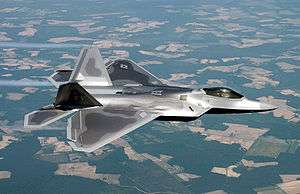27th Fighter Squadron
| 27th Fighter Squadron | |
|---|---|
|
F-22A 03-042, the 1st F-22A Assigned to the 27th Fighter Squadron, 2005 | |
| Active | 1917-present |
| Country |
|
| Branch |
|
| Type | Squadron |
| Role | Fighter |
| Part of | Air Combat Command |
| Garrison/HQ | Joint Base Langley–Eustis, Virginia |
| Nickname(s) | "Fighting Eagles" |
| Tail Code | "FF" |
| Engagements |
|
| Decorations |
|
| Insignia | |
| 27th Fighter Squadron emblem |
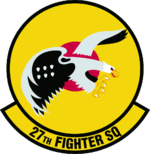 |
The 27th Fighter Squadron (27 FS) is a unit of the United States Air Force 1st Operations Group located at Joint Base Langley–Eustis, Virginia. The 27th is equipped with the F-22 Raptor.[1]
The 27th Fighter Squadron is the oldest active fighter squadron in the United States Air Force, with over 95 years of service to the nation. It was organized as the 21st (later 27th) Aero Squadron on 15 June 1917 at Kelly Field, Texas. The squadron deployed to France and fought on the Western Front during World War I as a pursuit squadron. It took part in the Champagne-Marne defensive; Aisne-Marne offensive; St. Mihiel offensive, and Meuse-Argonne offensive.[2]
During World War II the unit served in the Mediterranean Theater of Operations (MTO) as part of Twelfth Air Force as a P-38 Lightning fighter squadron, participating in the North African and Italian campaigns. During the Cold War it was both an Air Defense Command fighter-interceptor squadron as later as part of Tactical Air Command. It was the first USAF operational squadron equipped with the F-15A Eagle in January 1976.[3][4]
Overview
Known as the "Fightin' Eagles" or "Black Falcons", the squadron is equipped with the F-22 Raptor, having transitioned from the F-15 in 2005 to become the world's first operational F-22 squadron.
As one of two fighter squadrons of the 1st Fighter Wing, the 27th is tasked to provide air superiority for United States or allied forces by engaging and destroying enemy forces, equipment, defenses or installations for global deployment.
History
World War I
- see: 27th Aero Squadron for a complete World War I history
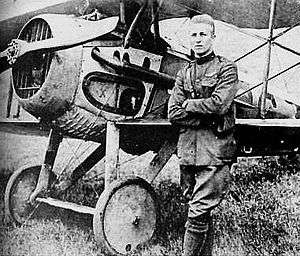
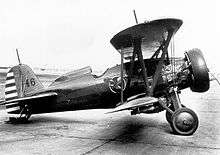
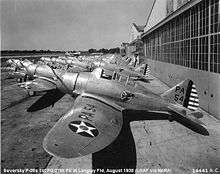
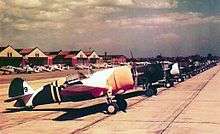



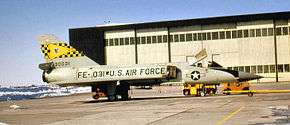

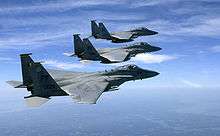
During World War I, the squadron was based at Toul (5 May 1918), Touquin (28 June 1918), Saints (9 July 1918) and Rembercourt (1 September 1918).
Lieutenant Frank Luke, Jr., known as the "Arizona Balloon Buster," for his daring feats against German observation balloons, was the squadron's most colorful ace. His 18 victories cost him his life, and he was awarded the Medal of Honor. Aircraft flown by the 27th during World War I include the Nieuport 28, Spad XIII and Sopwith F-1 Camel.
Between the wars
In the period between the world wars, the 27th Pursuit Squadron, re-designated 25 January 1923, was stationed primarily at Selfridge Field, Michigan, with the 1st Fighter Group. 27th Pursuit Squadron pilots participated in air races. In 1922, Lt. Donald Stace of the 27th AS won the first Mitchell Trophy Race.
Under extreme and austere conditions in the 1920s they tested the effects of cold weather on their aircraft. At times it was so cold, the engines of their P-1 Hawk aircraft would not start until steam was forced into the engines to thaw them.
While they were stationed at Selfridge Field, Mich., pilots from the 27th AS put on aerial demonstrations all over the country throughout the 1920s. One of those was at Langley Field in March, 1925. A large silhouette of a battleship on the grass landing strip served as a target, which was successfully strafed and bombed for several duly impressed congressmen.
The 1930s saw more training, additional cold weather tests and more modern aircraft. They participated in several air shows throughout the country, and even though they were in the military, the 27th Pursuit Squadron delivered the mail for a while. One of the pilots in this failed experiment went onto lead Strategic Air Command, then Lt. Curtis E. LeMay.
World War II
At the beginning of the United States' involvement in World War II, the 27th Fighter Squadron, redesignated 15 May 1942, briefly served in anti-submarine duty at San Diego Naval Air Station and in air defense duty at Reykjavík, Iceland. From October 1942 until May 1945, the 27th participated in the European and Mediterranean theaters of operation, flying Lockheed P-38 Lightnings. The squadron won three Distinguished Unit Citations in Italy 25 August 1943, and 30 August 1943; and at Ploesti, Romania, 18 May 1944. The 27th Fighter Squadron was the top-scoring unit of the 1st Fighter Group in World War II, with 83 of its pilots credited with 176.5 victories.
Cold War
Following World War II, the 27th was stationed at March Field, California, flying P-80 Shooting Stars, the United States' first operational jet aircraft. Upon the unit's redesignation as the 27th Fighter Interceptor Squadron, it moved to Niagara Falls Air Force Station, New York, flying the F-86, F-89 and F-94C aircraft while stationed at Griffis Air Force Base in Rome N.Y. until receiving the F-102 Delta Dagger in 1957. In October 1959, the 27th was transferred to Loring Air Force Base, Maine, where it assumed an air defense role flying F-106 Delta Darts in the Bangor Air Defense Sector.
On 22 October 1962, before President John F. Kennedy told Americans that missiles were in place in Cuba, the squadron dispersed one third of its force, equipped with nuclear tipped missiles to Olmsted Air Force Base at the start of the Cuban Missile Crisis.[5][6] These planes returned to Loring after the crisis.
The redesignated 27th Tactical Fighter Squadron was assigned to MacDill Air Force Base, Florida, 2 July 1971, as part of the reorganized 1st Tactical Fighter Wing, later the 1st Fighter Wing. While at MacDill, the 27th trained aircrews in the F-4E Phantom II. In June 1975, the 27th Tactical Fighter Squadron was moved to Langley Air Force Base, Virginia, becoming the first operational squadron to fly the F-15 Eagle air superiority fighter in 1976. The unit was redesignated the 27th Fighter Squadron on 1 September 1991. The 27th TFS deployed in support of Operation Desert Storm as part of the first U.S. Air Force contingent in Saudi Arabia. The squadron was integral in establishing allied air superiority during the operation.
Modern era
The 27th FS has deployed worldwide to support the 1st FW. The 27th Fighter Squadron deployed to Turkey in support of Operation Northern Watch, and to Saudi Arabia in support of Operation Southern Watch, flying F-15Cs in both operations enforcing UN sanctions against Iraq until 2003.
In 2003, the 27th Fighter Squadron was announced as the first operational squadron to fly the Raptor—a continuation of the squadron's historical legacy. The first F-22A arrived in late 2004 the squadron continues to grow as more Raptors arrive each month. The 27th Fighter Squadron today stands as a cohesive combat experienced team ready for any call to support the United States' security requirements.
2013 sequestration
Air Combat Command officials announced a stand down and reallocation of flying hours for the rest of the fiscal year 2013 due to mandatory budget cuts. The across-the board spending cuts, called sequestration, took effect 1 March when Congress failed to agree on a deficit-reduction plan.[7]
Squadrons either stood down on a rotating basis or kept combat ready or at a reduced readiness level called "basic mission capable" for part or all of the remaining months in fiscal 2013.[7] This affected the 27th Fighter Squadron with a reduction of its flying hours, placing it into a basic mission capable status from 5 April-30 September 2013.[7]
Lineage
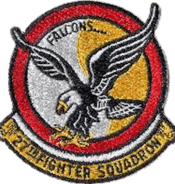
- Formed as: Company K, 3d Provisional Aero Squadron on 8 May 1917
- Organized as 21st Aero Squadron on 15 June 1917
- Redesignated as 27th Aero Squadron on 23 June 1917
- Redesignated as 27th Aero Squadron (Pursuit), on 20 March 1918
- Redesignated as 27th Aero Squadron on 19 March 1919
- Redesignated as 27th Squadron (Pursuit) on 14 March 1921
- Redesignated 27th Pursuit Squadron on 25 January 1923
- Redesignated 27th Pursuit Squadron (Interceptor) on 6 December 1939
- Redesignated 27th Pursuit Squadron (Fighter) on 12 March 1941
- Redesignated 27th Fighter Squadron (Twin Engine) on 15 May 1942
- Redesignated 27th Fighter Squadron, Two Engine, on 28 February 1944
- Inactivated on 16 October 1945
- Redesignated 27th Fighter Squadron, Single Engine, on 5 April 1946
- Redesignated 27th Fighter Squadron, Jet Propelled, on 20 June 1946
- Activated on 3 July 1946
- Redesignated 27th Fighter Squadron, Jet, on 15 June 1948
- Redesignated 27th Fighter-Interceptor Squadron on 16 April 1950
- Inactivated on 1 July 1971. Personnel and equipment redesignated 83d Fighter-Interceptor Squadron[8]
- Redesignated 27th Tactical Fighter Squadron and reactivated on 1 July 1971
- Redesignated 27th Fighter Squadron on 1 November 1991.
Assignments
- Post Headquarters, Kelly Field, 8 May 1917
- Aviation Section, U.S. Signal Corps
- Attached to the Royal Flying Corps for training, 18 August 1917 – 26 January 1918
- Aviation Concentration Center, 26 January-25 February 1918
- Air Service Headquarters, AEF, 20 March 1918
- 3d Air Instructional Center, 29 March 1918
- Air Service Headquarters, AEF, 24 April 1918
- 1st Pursuit Group, 1 June 1918
- 1st Air Depot, 12 December 1918
- Advanced Section Services of Supply, 5 February-8 March 1919
- Eastern Department, 19 March 1919
- Central Department, 1 June 1919
- 1st Pursuit (later, 1 Fighter) Group, 22 August 1919 – 16 October 1945
- 1st Fighter Group, 3 July 1946
- Attached to: Eastern Air Defense Force, 15 August 1950 – 3 June 1951
- Attached to: 103d Fighter Interceptor Group, 4 June 1951 – 6 February 1952
- 4711 Defense (later, 4711 Air Defense) Wing, 6 February 1952
- 32d Air Division, 1 March 1956
- Attached to 14th Fighter Group, 1 March 1956 – 17 February 1957
- 4727 Air Defense Group, 8 February 1957
- Bangor Air Defense Sector, 1 October 1959
- 36th Air Division, 1 April 1966
- 35th Air Division, 15 September 1969
- 21st Air Division, 19 November 1969
- 1st Tactical Fighter Wing, 1 July 1971
- Attached to 1 Tactical Fighter Wing, Provisional, 8 August 1990 – 8 March 1991
- 1 Operations Group, 1 October 1991–present
Stations
- World War I and interwar years
|
|
- World War II
|
|
- United States Air Force
|
|
Aircraft
|
|
See also
- Joseph Frank Wehner
- Norman Ralph Ross
- Frank Luke
- Jerry Vasconcells
- Donald Hudson
- John MacArthur[9]
- List of American Aero Squadrons
References
- ↑ Robertson, Patsy (22 July 2010). "Factsheet 27 Fighter Squadron (ACC)". Air Force Historical Research Agency.
- ↑ Series "E", Volume 9, History of the 25th-27th Aero Squadrons. Gorrell's History of the American Expeditionary Forces Air Service, 1917–1919, National Archives, Washington, D.C.
- ↑ Maurer, Maurer, ed. (1982) [1969]. Combat Squadrons of the Air Force, World War II (PDF) (reprint ed.). Washington, DC: Office of Air Force History. ISBN 0-405-12194-6. LCCN 70605402. OCLC 72556.
- ↑ Rogers, Brian. United States Air Force Unit Designations Since 1978. Hinkley, England: Midland Publications, 2005. ISBN 1-85780-197-0.
- ↑ McMullen, Richard F. (1964) "The Fighter Interceptor Force 1962-1964" ADC Historical Study No. 27, Air Defense Command, Ent Air Force Base, CO (Confidential, declassified 22 Mar 2000), pp. 10-12
- ↑ NORAD/CONAD Participation in the Cuban Missile Crisis, Historical Reference Paper No. 8, Directorate of Command History Continental Air Defense Command, Ent AFB, CO , 1 Feb 63 (Top Secret NOFORN declassified 9 March 1996). p. 16
- 1 2 3 Reduced flying hours forces grounding of 17 USAF combat air squadrons
- ↑ USAFHRA document 00463741
- ↑ American Aces of World War I. p. 86.
Bibliography
![]() This article incorporates public domain material from the Air Force Historical Research Agency website http://www.afhra.af.mil/.
This article incorporates public domain material from the Air Force Historical Research Agency website http://www.afhra.af.mil/.
- Cornett, Lloyd H.; Johnson, Mildred W. (1980). A Handbook of Aerospace Defense Organization, 1946–1980 (PDF). Peterson AFB, CO: Office of History, Aerospace Defense Center.
- Franks, Norman & Dempsey, Harry . (2001) American Aces of World War I. Osprey Publishing, 2001. ISBN 1-84176-375-6, ISBN 978-1-84176-375-0.
- Maurer, Maurer, ed. (1982) [1969]. Combat Squadrons of the Air Force, World War II (PDF) (reprint ed.). Washington, DC: Office of Air Force History. ISBN 0-405-12194-6. LCCN 70605402. OCLC 72556.
- McMullen, Richard F. (1964) "The Fighter Interceptor Force 1962-1964" ADC Historical Study No. 27, Air Defense Command, Ent Air Force Base, CO (Confidential, declassified 22 Mar 2000)
- Rogers, Brian. (2005). United States Air Force Unit Designations Since 1978. Hinkley, UK: Midland Publications. ISBN 1-85780-197-0.
- NORAD/CONAD Participation in the Cuban Missile Crisis, Historical Reference Paper No. 8, Directorate of Command History Continental Air Defense Command, Ent AFB, CO, 1 Feb 63 (Top Secret NOFORN declassified 9 March 1996)
- United States War Department (1920), Battle Participation of Organizations of the American Expeditionary Forces in France, Belgium and Italy, 1917-1919, Washington, Government Printing Office, 1920
External links
| Wikimedia Commons has media related to 27th Fighter Squadron. |
- 27th Fighter Squadron fact sheet
- 14 July 2008 - 90th anniversary Commemoration of 27th, 94th, 95th, 147th aero squadrons in France
- 14 July 2008 - 90th anniversary Commemoration of 27th, 94th, 95th, 147th aero squadrons in France
